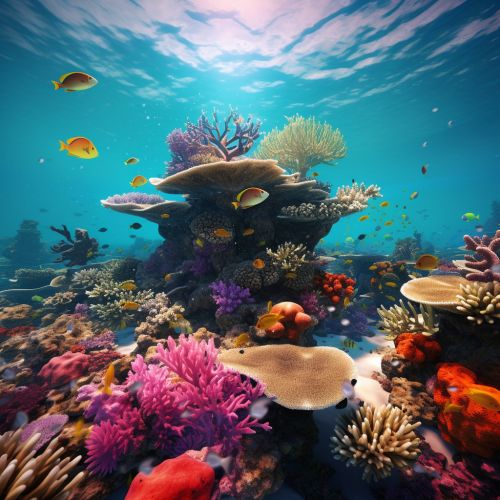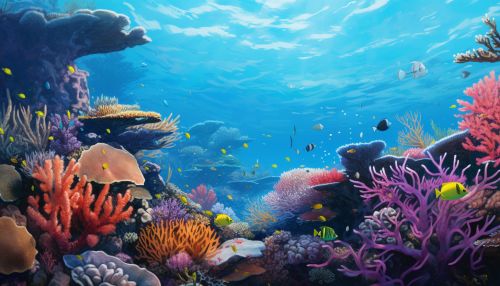Climate Change Impacts on Coral Reefs
Introduction
Climate change is a significant and lasting change in the statistical distribution of weather patterns over periods ranging from decades to millions of years. It may be a change in average weather conditions, or in the distribution of weather around the average conditions (i.e., more or fewer extreme weather events). Climate change is caused by factors such as biotic processes, variations in solar radiation received by Earth, plate tectonics, and volcanic eruptions. Certain human activities have been identified as primary causes of ongoing climate change, often referred to as global warming.


Impact on Coral Reefs
Coral reefs are diverse underwater ecosystems held together by calcium carbonate structures secreted by corals. Coral reefs are built by colonies of tiny animals found in marine water that contain few nutrients. Most coral reefs are built from stony corals, which in turn consist of polyps that cluster in groups. The polyps belong to a group of animals known as Cnidaria, which also includes sea anemones and jellyfish. Unlike sea anemones, corals secrete hard carbonate exoskeletons that support and protect the coral animals; the polyps are generally only a few millimeters in diameter, and each secrete an exoskeleton near the base. Over many generations, the colony thus creates a large skeleton characteristic of the species. Individual colonies grow by asexual reproduction of polyps. Corals also breed sexually by spawning: polyps of the same species release gametes simultaneously overnight, often around a full moon.
However, coral reefs are facing significant challenges due to the impacts of climate change. The increase in sea surface temperatures, ocean acidification, and sea-level rise are among the key climate change factors that are impacting coral reef ecosystems.
Increase in Sea Surface Temperatures
One of the most immediate and visually evident impacts of climate change on coral reefs is coral bleaching. Coral bleaching is a stress response of corals due to the increase in sea surface temperatures. When water is too warm, corals will expel the algae (zooxanthellae) living in their tissues causing the coral to turn completely white. This is called coral bleaching. When a coral bleaches, it is not dead. Corals can survive a bleaching event, but they are under more stress and are subject to mortality.
Ocean Acidification
Ocean acidification is another significant impact of climate change on coral reefs. The increase in the concentration of carbon dioxide in the atmosphere leads to more carbon dioxide dissolving into the oceans. When carbon dioxide dissolves in seawater, the water becomes more acidic and the ocean's pH (a measure of how acidic or basic the ocean is) drops. Even slight changes in the pH of seawater can have harmful effects on marine life, affecting reproduction, growth, and development, and reducing the ability of some species to build shells and skeletons.
Sea-Level Rise
Sea-level rise is another impact of climate change that affects coral reefs. Coral reefs need to be close to the surface of the water to survive, as they require sunlight to grow. A rise in sea level can lead to increased sedimentation for reefs located near land-based sources of sediment. Sedimentation can have significant impacts on reef ecosystems, as it can smother corals and interfere with their ability to feed and reproduce.
Mitigation and Adaptation Strategies
There are several mitigation and adaptation strategies that can be employed to protect coral reefs from the impacts of climate change. These include reducing greenhouse gas emissions, protecting and restoring coral reefs, and researching and monitoring reef ecosystems.
Reducing Greenhouse Gas Emissions
Reducing greenhouse gas emissions is the most effective way to mitigate the impacts of climate change on coral reefs. This can be achieved through a variety of strategies, including increasing energy efficiency, switching to renewable energy sources, and implementing carbon capture and storage technologies.
Protecting and Restoring Coral Reefs
Protecting and restoring coral reefs can help to mitigate the impacts of climate change. This can be achieved through a variety of strategies, including establishing marine protected areas, implementing sustainable fishing practices, and restoring damaged reefs through coral gardening and other restoration techniques.
Researching and Monitoring Reef Ecosystems
Researching and monitoring reef ecosystems is crucial for understanding the impacts of climate change on coral reefs and for developing effective mitigation and adaptation strategies. This can involve monitoring changes in reef health and composition, researching the effects of climate change on reef species and ecosystems, and developing and testing new strategies for reef conservation and management.
